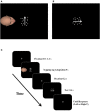Mentalizing Another's Visual World-A Novel Exploration via Motion Aftereffect
- PMID: 28936191
- PMCID: PMC5594217
- DOI: 10.3389/fpsyg.2017.01535
Mentalizing Another's Visual World-A Novel Exploration via Motion Aftereffect
Abstract
Past research on level 2 visual perspective-taking (VPT) has mostly focused on understanding the mental rotation involved when one adopts others' perspective; the mechanisms underlying how the visual world of others is mentally represented remain unclear. In three studies, we addressed this question by adopting a novel VPT task with motion stimuli and exploring the aftereffect on motion discrimination from the self-perspective. Overall the results showed a facilitation aftereffect when participants were instructed to take the avatar's perspective. Meanwhile, participants' self-reported perspective-taking tendencies correlated with the aftereffect for both instructed and spontaneous VPT tasks, when the "to-be-adopted" perspective required the participants to mentally transform their self-body clockwise. Specifically, while facilitation was induced for participants with low self-reported perspective-taking tendencies (e.g., viewing a leftward motion stimulus under another's perspective enhanced subsequent perception of leftward motion from the self-perspective), those with high self-reported perspective-taking tendencies showed an adaptation aftereffect (e.g., viewing a leftward motion stimulus under another's perspective weakened subsequent perception of leftward motion from the self-perspective). For these individuals, the adaptation effect indicated the engagement of direction-selective neurons in processing of the subsequent congruent-direction motion from self's perspective. These findings suggest that motion perception from different perspectives (self vs. another) may share the same direction-selective neural circuitry, and this possibility depends on observers' general perspective-taking tendencies.
Keywords: aftereffect; facilitation; mentalization; motion adaptation; visual perspective-taking.
Figures






Similar articles
-
Spontaneous Vicarious Perception of the Content of Another's Visual Perspective.Curr Biol. 2019 Mar 4;29(5):874-880.e4. doi: 10.1016/j.cub.2019.01.046. Epub 2019 Feb 21. Curr Biol. 2019. PMID: 30799242
-
Lack of implicit visual perspective taking in adult males with autism spectrum disorders.Res Dev Disabil. 2020 Apr;99:103593. doi: 10.1016/j.ridd.2020.103593. Epub 2020 Feb 5. Res Dev Disabil. 2020. PMID: 32035319
-
Is implicit Level-2 visual perspective-taking embodied? Spontaneous perceptual simulation of others' perspectives is not impaired by motor restriction.Q J Exp Psychol (Hove). 2022 Jul;75(7):1244-1258. doi: 10.1177/17470218221077102. Epub 2022 Feb 25. Q J Exp Psychol (Hove). 2022. PMID: 35040382 Free PMC article.
-
[MOTION AFTEREFFECT AS A UNIVERSAL PHENOMENON IN SENSORY SYSTEMS INVOLVED IN SPACE ORIENTATION. II. AUDITORY MOTION AFTEREFFECT].Zh Evol Biokhim Fiziol. 2015 May-Jun;51(3):145-53. Zh Evol Biokhim Fiziol. 2015. PMID: 26281216 Review. Russian.
-
Spatial perspective-taking: insights from sensory impairments.Exp Brain Res. 2022 Jan;240(1):27-37. doi: 10.1007/s00221-021-06221-6. Epub 2021 Oct 29. Exp Brain Res. 2022. PMID: 34716457 Free PMC article. Review.
Cited by
-
Online level-2 perspective taking for newly learnt symbols.Cogn Process. 2025 May;26(2):331-343. doi: 10.1007/s10339-024-01244-7. Epub 2024 Nov 21. Cogn Process. 2025. PMID: 39570500 Free PMC article.
-
How the brain memorizes the world from others' perspectives: investigating allocentric encoding of object features during perspective taking.BMC Psychol. 2025 Jul 1;13(1):691. doi: 10.1186/s40359-025-03022-2. BMC Psychol. 2025. PMID: 40597457 Free PMC article.
-
Embodied Cross-Modal Interactions Based on an Altercentric Reference Frame.Brain Sci. 2024 Mar 27;14(4):314. doi: 10.3390/brainsci14040314. Brain Sci. 2024. PMID: 38671966 Free PMC article.
References
-
- Apperly I. A., Samson D., Chiavarino C., Humphreys G. W. (2004). Frontal and temporo-parietal lobe contributions to theory of mind: neuropsychological evidence from a false-belief task with reduced language and executive demands. J. Cogn. Neurosci. 16, 1773–1784. 10.1162/0898929042947928 - DOI - PubMed
-
- Davis M. H. (1980). A multidimensional approach to individual differences in empathy. JSAS Catalog Select. Doc. Psychol. 10, 85–103.
LinkOut - more resources
Full Text Sources
Other Literature Sources
Miscellaneous

